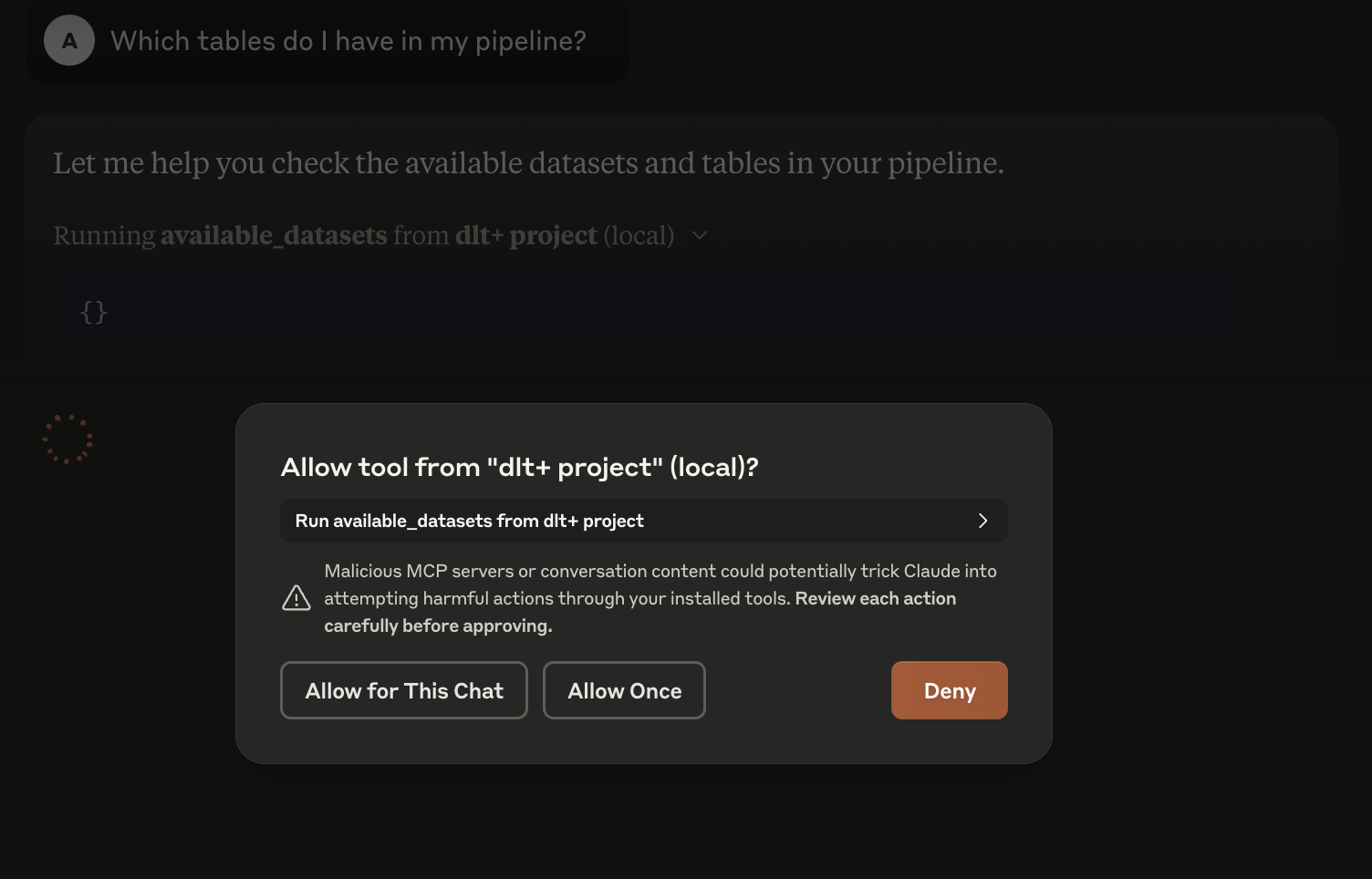AI workflows
This page is for dltHub Feature, which requires a license. Join our early access program for a trial license.
As part of dltHub, we are developing several tools to enhance development with AI workflows. The first of these is a Model Context Protocol (MCP) plugin for Claude Desktop for data exploration.
Prerequisites
- dltHub installed in a virtual environment (see installation guide)
- Claude Desktop installed
Install dltHub with MCP support
Make sure your virtual environment is activated, then:
pip install dlthub[mcp]
Set up or use a dltHub project
You can either use your existing dltHub project or create a simple test project to try out the MCP workflow.
Using an existing project
If you already have a dltHub project, you can use it directly - just make sure you have run at least one pipeline so there's some data to explore. You can skip to configure Claude Desktop if you have a project ready.
Creating a test project
If you don't have a project yet, here's how to create a simple one:
On Unix-based systems:
touch dlt.yml
Alternatively, you can create an empty dlt.yml file in any text editor.
Copy and paste the following configuration into the dlt.yml file:
sources:
pokemon_api:
type: dlt.sources.rest_api.rest_api
client:
base_url: https://pokeapi.co/api/v2
resource_defaults:
endpoint:
params:
limit: 1000
resources:
- pokemon
- berry
- location
destinations:
pokemon_local:
type: filesystem
bucket_url: pokemon_data
pipelines:
pokemon:
source: pokemon_api
destination: pokemon_local
dataset_name: pokemon_dataset
datasets:
pokemon_dataset:
destination:
- pokemon_local
This will create a dltHub project with a single pipeline that loads data from the Pokemon API and stores it in a local directory.
Validate the project configuration:
dlt project config validate
If the configuration is valid, you should see the following message:
Configuration validation successful!
That means you can now run the pipeline to get some data:
dlt pipeline pokemon run
If the pipeline runs successfully, you should see the following message:
1 load package(s) were loaded to destination pokemon_local and into dataset pokemon_dataset
The pokemon_local destination used file:///path/to/your/project/_data/dev/local/pokemon_data location to store data
Load package 1739383145.0668569 is LOADED and contains no failed jobs
Great, you have some data in your project. The next step is configuring Claude Desktop, but for this, you'll need to get a path to your dlt executable. When you are using a virtual environment, the dlt executable is typically located in its bin directory (on Unix-like systems). For example, if your virtual environment is located in a .venv directory, the path to the dlt executable is .venv/bin/dlt.
Running which dlt in your terminal will give you the path to the dlt executable. Take note of it; we will use it in the next step.
Configure Claude Desktop
Make sure you have installed Claude Desktop and have an account.
Update Claude desktop config
In Claude Desktop, go to settings (in macOS, Claude > Settings) and under "Developer," click "Edit Config." You will see the location of the claude_desktop_config.json file.
Open the file in a text editor and add the following configuration:
{
"mcpServers": {
"dltHub project": {
"command": "</path/to/your/project/.venv/bin/dlt>",
"args": [
"project",
"--project",
"<path/to/your/project>",
"mcp"
]
}
}
}
Replace </path/to/your/project/.venv/bin/dlt> with the path to your dlt executable from the previous step and save the file.
If you are using environment variables to configure dlt, make sure to include them as part of the command before the dlt executable.
Restart Claude desktop
Important: Restart Claude Desktop so the new configuration is loaded.
Make sure to restart Claude Desktop after you have updated the config.
Check the connection
After you have restarted Claude Desktop, you can check the connection by looking at the tool icon in the bottom right corner of the chat box:
![]()
If you do not see the icon, ensure your claude_desktop_config.json is saved properly and that Claude Desktop was fully restarted.
When you click on the icon, you will see the "Available MCP Tools" popup with the tool's description.

Start chatting
Now you can start chatting with Claude Desktop and ask it questions about the data in your dltHub project.
For example, you may ask, "Which tables do I have in my pipeline?":

Claude will ask you for permission to run the tool locally:

After you grant the permission, Claude Desktop will run the tool (available_datasets) and (depending on the result) may proceed with selecting and running other tools.
To see all the available tools, click on the tool icon in the bottom right corner of the chat box.
More examples of the queries you can ask:
- "What columns does the pokemon table have?"
- "How many rows are in the pokemon table?"
- "Transform the pokemon table to add a new column with the pokemon name length."
- "What is the average height of the pokemon?"
That's it! You can now explore your dltHub project from Claude Desktop using the MCP.